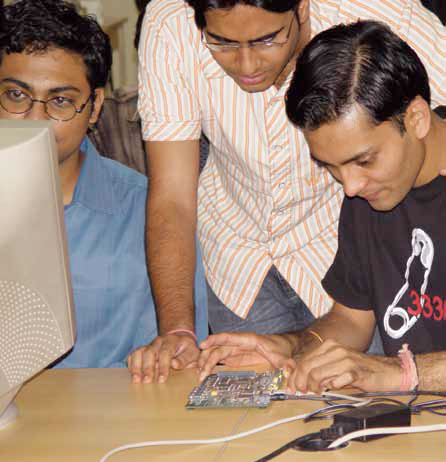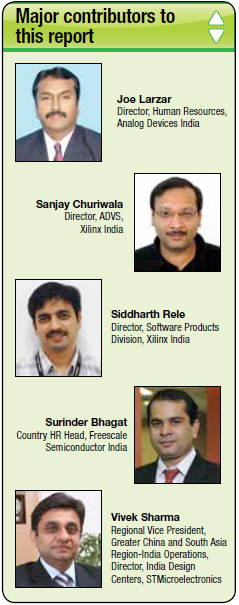 Most of the electronic devices around us contain a processor with some embedded software. Unlike desktop computers, which can be programmed to do any general-purpose task, these embedded systems do highly focused and specific jobs.
Most of the electronic devices around us contain a processor with some embedded software. Unlike desktop computers, which can be programmed to do any general-purpose task, these embedded systems do highly focused and specific jobs.
The market for embedded systems is quite big. Increasing sales of consumer electronics goods, telecom/ networking market and growth in the use of portable/wireless products globally are driving the growth of the semiconductor design industry.
If you have a creative and innovative bent of mind, a career in embedded systems can be extremely rewarding. The industry offers a variety of jobs in the areas of chip design, applications engineering, product and test engineering, systems design and embedded software development. The positions in these job families range from the role of a technical individual contributor to technical lead position to an engineering management role.
Lots of embedded systems work— in particular, embedded software development—is being done in India. The embedded software industry is expanding as third-party service providers are moving up the value chain. Captives largely work on the hardware abstraction layer and the device driver layer. While many captives outsource application-related work to third-party service providers and Indian design companies to shorten their time-to-market, others prefer to grow their domain-specific embedded application expertise in-house.
Embedded system fundamentals
An embedded system consists of hardware and software. When chips are built into systems and software is loaded on that for a particular functionality, it becomes an embedded system. VLSI is used to design integrated circuits by combining millions and billions of transistors into a single chip, and involves various design activities ranging from specification to tape-out of the chip. VLSI results in reduced sizes and costs for embedded systems. Instead of using separate chips for the processor, memory and associate digital circuitry, one can build a single integrated circuit that contains the complete functionality of the embedded system.
and software is loaded on that for a particular functionality, it becomes an embedded system. VLSI is used to design integrated circuits by combining millions and billions of transistors into a single chip, and involves various design activities ranging from specification to tape-out of the chip. VLSI results in reduced sizes and costs for embedded systems. Instead of using separate chips for the processor, memory and associate digital circuitry, one can build a single integrated circuit that contains the complete functionality of the embedded system.
While the embedded system sits on top of everything, VLSI is the core part of an embedded system as the whole system depends on VLSI design.
Roles available
Embedded engineers write the software that controls the VLSI chips. Embedded software can be any code which interacts with the hardware layer, ranging from the hardware abstraction layer, device drivers, kernel programming to application programming.
To take up embedded software development as career, you need to have a working knowledge of C, C++ and Java, with some exposure to application software development. If you have already done some programming for an embedded system, you can expand your horizons by broadening your skill sets. Embedded software is being developed using a variety of embedded and real-time operating systems, such as embedded NT, Windows CE and RTLinux. In addition, a variety of development tools and IDEs for C, C++ and Java are available. You need to learn application development in these various environments.
To be a successful programmer, you need a good understanding of design alternatives—how to choose a processor, an operating system, a programming language so that you can develop cost-effective, reliable embedded software with minimal development time. As many of the systems become network enabled, a working knowledge of network programming is also important. Also, you need to be aware of the diversity of application areas and the specific requirements of each.
As a hardware/board designer, you could work on reference board design, new board design, and board design derivatives and modifications on existing boards. Reference boards are used to validate the capabilities of designed silicon chips.
The embedded hardware designer is responsible for hardware design schematic , PCB layout, BOM creation, hardware board debugging and testing, and system integration testing. Desired skills are hardware design using 8-/16-/32-bit microcontrollers, microprocessor-based systems, design of medium-frequency boards, hardware design of analogue , mixed signal and digital, and understanding/ implementation of the EMI and EMC concepts to hardware design.
3.5 million jobs by 2015, but talent missing
The Indian semiconductor design industry, comprising very large-scale integrated (VLSI) design, board design and embedded software companies, has set its footprints across the country.
According to an ISA-Ernst & Young report of 2011, this industry was about $6.5 billion in 2009 and is expected to log a compound annual growth rate of 17.3 per cent to reach $10.6 billion in 2012.
The report also suggests that the industry promises 3.5 million jobs by 2015. But unfortunately, the industry is grappling with the problem of talent shortage.
Embedded software segment now offers more high-value activities relating to middleware, driver design and associated applications. The main reason for increased adoption of embedded software is its use by electronics companies for increased device functionality, reduced time-to-market and reduction in costs.






